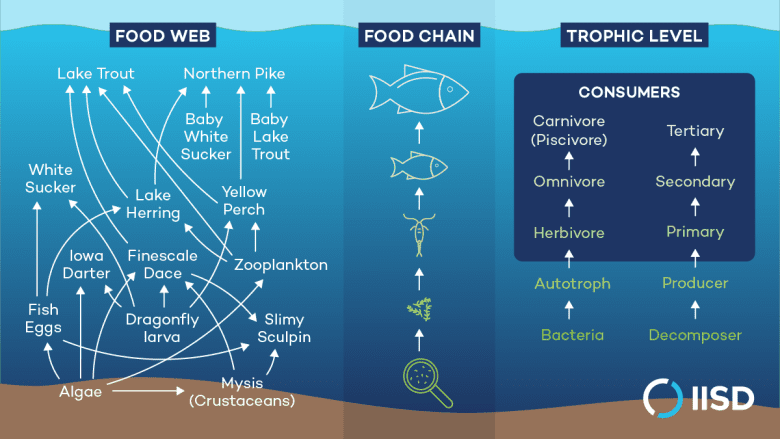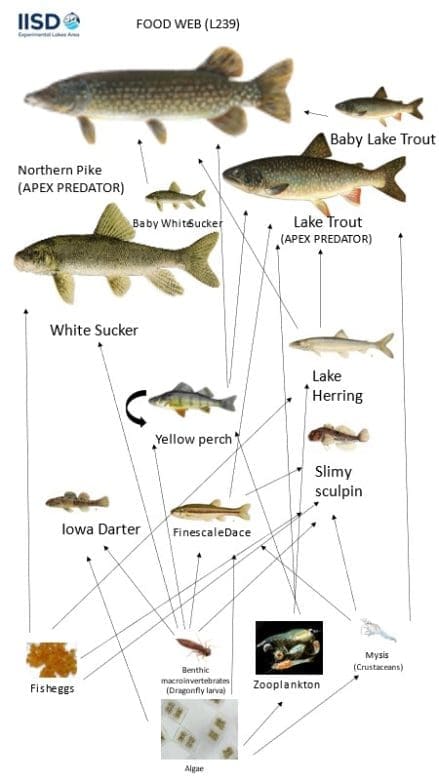Back to Basics September 28, 2021
BACK TO BASICS: Who Eats Whom in Fresh Water
By Savana Theodore-Maraj
Food is a necessity for all life on earth; however, the way plants and animals obtain their meals varies. The interactions between water, land and other elements such as carbon are important processes and affect everything from the smallest critters like zooplankton to large fish like northern pike.
Aquatic ecosystems are vital habitats, resources, and recreational spaces for humans. Understanding the dynamic relationships of food web, food chain, and trophic level interactions in freshwater environments is important for recognizing and mitigating anthropogenic (human) influences on species.
Allow us to explain further.
Food Web, Food Chain, Trophic Level: What is the difference?
Although these terms are similar and used interchangeably, they differ in their definitions and the way they categorize organisms that live and interact in ecosystems.

A food chain is a path for energy and nutrients to go from organism to organism. For example, a basic aquatic food chain would be that algae makes its food from the sun and is eaten by zooplankton, zooplankton are eaten by yellow perch, and yellow perch are eaten by lake trout.
A food web is all the food chains in an ecosystem. Organisms can play multiple roles in the food web and individual food chains. For example, a fathead minnow may be the end of one food chain but could be the start of another. This is where trophic levels come in to play.
Trophic levels are how organisms in food webs and chains are organized. The categories are based on what they eat: producers, consumers, and decomposers, with producers and consumers further categorized into levels.
- Producers—also known as autotrophs—are the first level; they make their food through the process of photosynthesis.
- Consumers are split into three categories. Herbivores, also known as primary consumers, are the second level and eat only plants. Omnivores, also known as secondary consumers, are the third level and eat both plants and animals. Carnivores, also known as tertiary consumers, are the fourth level and eat only other animals.
- Apex predators are tertiary consumers and are sometimes categorized as their own level as these animals do not have any natural enemies besides humans.
- Decomposers include scavengers (eat the nonliving remains of animals and plants) along with fungi and bacteria that turn organic waste from those remains into inorganic materials. They complete the food chain cycle by returning those nutrients back to the environment for autotrophs to use.
What Direction Does Food Go?
There is more to food than just who eats whom. A balanced ecosystem is necessary to ensure all levels of the food web have enough to eat. Factors that control this balance are known as top down and bottom up.
- Top down suggests that apex predators or higher-level consumers limit or control the lower levels of food through predation. In Lake 239 at IISD-ELA, Northern Pike is an apex predator that keeps other fish population numbers controlled through predation. This interaction limits the lower levels of fish that can prey upon other levels of the food chain, thus ensuring resources are stable and not completely depleting.
- Bottom up suggests that the availability of resources or autotrophs limits and controls the upper levels. This theory can be seen at IISD-ELA in the relationship between Daphnia (zooplankton species) and algae. During the open water season, algae populations increase in the lakes. This leads to Daphnia populations increasing, which can then cascade up through the food web.
When these processes are out of balance due to influences (usually from humans), a trophic cascade can occur. This is the result of a significant change in one trophic level (such as removal of a species) affecting the other levels.
Our Lakes at IISD-ELA
At IISD-ELA, we have 58 lakes that comprise various organisms and food webs. Lake 239 is an interesting lake not only because it is one of our long-term monitoring lakes but, because it has lake herring, it is able to support two apex predators (lake trout and northern pike)! This lake also has quite a few piscivores (fish that only eat fish).
Looking at the Lake 239 food web, see if you can figure out what trophic level each species would belong to.
Answers are at the bottom of the page.

Research, Education, Monitoring
Studying the responses and effects of species on all levels is part of what makes whole-lake ecosystem studies such a unique and valuable way to research fresh water. Understanding the effects on various parts of food webs is vital, as has been demonstrated in our study on the effects of acid rain. Without the unique whole-lake process IISD-ELA does we would not have identified the trophic cascade caused by the impacts of acid rain on Mysis which led to lake trout starving.
Long-term monitoring is another important aspect of our work and for looking at responses to food web and trophic interactions. Cyndy Desjardins our food web biologist, conducts research and monitors food web interactions focusing on zooplankton. Our fish crew monitors fish species in the lakes to see how the effects of whole-ecosystem experiments are cascading through the food web and affecting the fish that feed on various trophic levels.
Food web answers:
Producers:
- Algae
Consumers:
- Primary (herbivores)
- Zooplankton
- Secondary (omnivores)
- Finescale dace
- Iowa darter
- Mysis
- Tertiary (carnivores/piscivores)
- White sucker
- Lake herring
- Yellow perch
- Slimy sculpin
- Apex predators
- Northern pike
- Lake trout